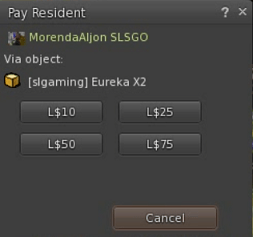If you play for e.g. L$20, you can win twice L$20 = L$40 when beating the target score.
Let's pay the game L$10 and start a game. I'll walk you through the game step by step.

If you play for e.g. L$20, you can win twice L$20 = L$40 when beating the target score.
Let's pay the game L$10 and start a game. I'll walk you through the game step by step.
Where to play?
Click a link to teleport directly to the Eureka! game machines.